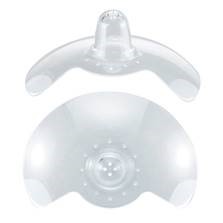
Description: Nipple shields are made of thin soft silicone that does not interfere with stimulation. These are an effective breastfeeding aid when nipples are flat, sensitive or wounded, for feeding a premature, small or ill infant, or when trying to wean a bottle fed baby back to the breast.
- Use under direction of a physician, breastfeeding consultant or other health professional
- Each nipple shield has 4 small holes at the top

Description: Nipple shields are made of thin soft silicone that does not interfere with stimulation. These are an effective breastfeeding aid when nipples are flat, sensitive or wounded, for feeding a premature, small or ill infant, or when trying to wean a bottle fed baby back to the breast.
- Use under direction of a physician, breastfeeding consultant or other health professional
- Each nipple shield has 4 small holes at the top

Amidst the excitement and anticipation of your pregnancy, you are more than likely to encounter a sea of well-meaning advice and information, not all of which is accurate. This is especially true when it comes to breastfeeding. Breastfeeding is a beautiful and natural way to nourish your baby, providing them with essential nutrients and antibodies for a healthy start. However, the benefits and naturalness of breastfeeding lead to some tall tales about its powers and ease. These tall tales are often referred to as “breastfeeding myths.”
Let’s bust some common breastfeeding myths and empower you to navigate your breastfeeding journey with confidence:
Myth 1: Breastfeeding is easy and natural.
While breastfeeding is a natural instinct, it doesn’t always come easily. Learning proper latching, establishing a routine, and managing potential challenges can take time and practice for both you and your baby. Don’t be discouraged if it takes a few tries – seek support from lactation consultants, nurses, or experienced mothers to overcome initial hurdles. You can schedule an appointment with a lactation consultant here.
Myth 2: Sore nipples are inevitable.
While some initial discomfort is common, especially in the first few days, ongoing pain is not normal. Ensure your baby is latching correctly, as a poor latch can lead to nipple soreness, and even bleeding. If you experience persistent pain, consult a lactation consultant for guidance on positioning and latch techniques.
Myth 3: You need to wash your nipples before every feeding.
Washing your nipples with soap before each feeding is unnecessary and can even disrupt the natural protective oils on your skin. Your baby benefits from the natural bacteria on your breasts, which helps build their immune system.
Myth 4: You can’t breastfeed if you have flat or inverted nipples.
Flat or inverted nipples can make latching more challenging, but it doesn’t mean you can’t breastfeed. With the help of a lactation consultant, you can learn techniques like nipple shields or positioning strategies to ensure successful breastfeeding.
Myth 5: Your breast size determines your milk supply.
Breast size has little to do with milk production. Your body produces milk based on the frequency and duration of your baby’s feeding, not the size of your breasts. The more your baby feeds, the more milk your body will produce to meet their needs.
Myth 6: You need to follow a strict diet while breastfeeding.
While a healthy diet is important for overall well-being, there’s no need for drastic dietary changes while breastfeeding. Focus on a balanced diet that includes fruits, vegetables, whole grains, and lean protein. Most foods won’t affect your milk supply or harm your baby.
Myth 7: Formula is just as good as breast milk.
While formula can be a safe and necessary alternative in some cases, breast milk provides unmatched benefits for your baby’s health and development. It contains essential nutrients, antibodies, and immune-boosting factors that formula cannot replicate. Your breastmilk will even naturally change and adapt to your baby’s needs.
Myth 8: You can’t breastfeed if you’re taking medication.
Most medications are compatible with breastfeeding. Consult your doctor to discuss any concerns and ensure you’re taking medications that are safe for both you and your baby.
Myth 9: You have to breastfeed on demand, even at night.
It is true that baby will, most likely, wake often during the night, especially in the early weeks. While frequent feeding is crucial for establishing milk supply, it’s okay to set boundaries and take breaks when needed. Your partner or a trusted caregiver can help with nighttime feedings to allow you some rest.
Myth 10: Breastfeeding is an all-or-nothing proposition.
Every breastfeeding journey looks different. Some mother’s choose to only feed at the breast while others solely pump and bottle feed. Others do a combination of the two. Even if you can’t exclusively breastfeed, every drop of breast milk your baby receives is beneficial. Combining breastfeeding with formula can still provide your baby with valuable nutrients and antibodies.
Remember, every breastfeeding journey is unique. Don’t hesitate to seek support from lactation consultants, healthcare professionals, and other breastfeeding mothers. Here’s a secret: most mothers do get help of some sort before they start feeling comfortable!
Hygeia Health is dedicated to supporting your breastfeeding journey. We offer a hospital-grade electric breast pump designed for comfort, efficiency, and portability, making it easier to express and store milk on the go.
Click here to learn how your insurance can cover the cost of our hospital strength pump and empower yourself to breastfeed with confidence!

Breastfeeding latch may be natural, but that doesn’t guarantee the initial latching process will come naturally–for you or baby. Achieving that successful latch can sometimes feel like a complex enigma, especially for new moms. However, it’s an essential step in achieving fruitful breastfeeding goals. A strong latch will guarantee your comfort as well as your baby’s ability to fill up on milk effectively.
This quick guide will equip you with the knowledge and strategies to master the art of the breastfeeding latch, setting you and your baby on the path to a smooth and joyful breastfeeding journey.
Why is a Good Latch Important?
A proper latch ensures your baby receives the nutritious hindmilk, the fattier milk that comes after the initial foremilk. That’s not to mention that a good latch helps prevent nipple pain, promotes milk production, and reduces the risk of blocked ducts and mastitis.
Signs of a Good Latch:
Wide Mouth Opening: Your baby’s mouth should be wide open, with a good portion of your areola (the darker area around the nipple) visible above their upper lip.
Deep Latch: Your baby’s chin should be resting on your breast, and their lips flanged outward, forming a seal around your areola.
Comfortable Feeding: You shouldn’t experience any nipple pain during feeding. You may feel a tugging sensation, but it shouldn’t be sharp or uncomfortable.
Effective Swallowing: Observe your baby swallowing regularly during feeding, with pauses in between sucks.
Strategies for Achieving a Good Latch:
Skin-to-Skin Contact: Initiate feeding with skin-to-skin contact. This not only promotes bonding but also encourages your baby to root and latch on instinctively.
Support Your Breast: Use a C-hold (thumb on top and fingers cupping underneath) to support your breast without blocking your baby’s nose.
Tickle and Trigger: Gently tickle your baby’s lips with your nipple to stimulate their rooting reflex. Wait for them to open their mouth wide before offering your breast.
Aim High: Aim your nipple towards the roof of your baby’s mouth, not just the tip.
Observe and Adjust: Pay close attention to your baby’s cues and adjust your positioning or latch if needed. Don’t be afraid to seek help from a lactation consultant if you’re struggling.
Common Latch Challenges and Solutions:
Shallow Latch: If your baby isn’t latching deeply enough, try unlatching them and repeating the steps above, ensuring they take a bigger mouthful of breast tissue.
Tongue Tie: Ankyloglossia, or tongue tie, can restrict your baby’s tongue movement and make latching difficult. Consult your doctor or a lactation consultant to discuss if a frenotomy (tongue-tie release) is the right solution.
Flat or Inverted Nipples: While flat or inverted nipples can pose a challenge initially, they don’t necessarily prevent successful breastfeeding. There are techniques and tools like nipple shields that can help your baby latch.
Supporting Your Breastfeeding Journey Every Step of the Way
At Hygeia Health, empowering mothers on their breastfeeding journeys is our priority. While breast pumps may be our specialty, we understand the importance of a good latch and offer a variety of resources to support you, including:
Informative blog posts: Our blog is packed with valuable information on various breastfeeding topics, including latching techniques.
Insurance-covered lactation consultations: We can connect you with a lactation consultant who can provide personalized guidance and support. Click here to learn more about Hygeia Health’s breastfeeding resources and insurance-covered lactation consultations!
Embrace the joy of breastfeeding with a confident latch and the support you deserve!



